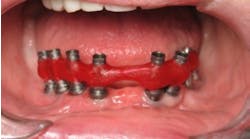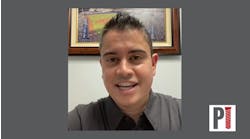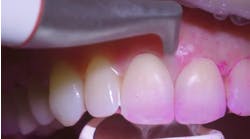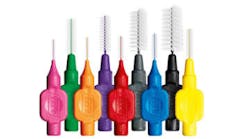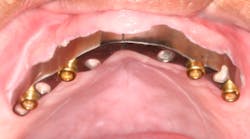By Steven Pigliacelli, CDT, MDT
The last 10 years have seen a sharp decline in trained dental technicians due to outsourcing and offshoring to foreign laboratories. Many universities have closed their on-site dental labs and are sending their work to China. There were 50,000 dental technicians in 1980, and now there are approximately 30,000. About 50% of the 30,000 are at or near retirement age. In 10 years we could see a decrease in dental technicians to 15,000. Last year 4,000 dental labs closed. Most of the schools have closed down, and we are seeing a rapid decline in enrollment in the existing programs. We’d like to see this trend reversed.
The morale of the dental technician community is at an all-time low. The U.S. Department of Labor labels dental technicians as unskilled labor. Contrary to the belief that dental labs make high salaries, the wages for the average technician is below average. Many technicians are paid per unit as a means to increase their salary by “knocking out” a lot of units.
The average price of a porcelain-fused-to-metal crown has not increased at the same rate as the national cost of living index. Social Security cost of living adjustments have risen by 117% since 1980. A “high priced” PFM crown in 1980 was $100, and an average priced PFM was $75. Today, a high-priced PFM is $200, while an average price PFM is $130, or $25 when received from China. The dentist’s per unit rule was to charge five times the lab fee. Does the average dentist today charge $125 to $1,050 per unit?
The costs of materials, labor, health care, and alloy have risen dramatically in the last 10 years. Gold alloys have been averaging $1,500 an ounce. The alloys of gold palladium and silver palladium are the basis for crown and bridge and implant restorations. Combined with the high cost of authorized implant components, an implant restoration will far exceed the desired price before even being started. The profit margin for a dental lab is so low that the only options are to cut costs with cheaper, possibly substandard materials such as nonprecious alloy; produce more units in less time, which reduces quality; or outsource.
But outsourcing is not the answer. Outsourcing dramatically affects the American dental technology industry, as it does in many other American industries. It is more profitable and less stressful to accept work from a dentist; repackage it and send it to China, Mexico, the Philippines, etc.; receive the finished product for $29; mark it up to $130; and send it back to the dentist. This way there are no labor or material costs. For the short term, this sounds like a viable option. But for the long term, the industry will continue to shrink. What the future may hold is no neighborhood labs for custom work or quality work. Face-to-face case planning will be a thing of the past. Sending the patient to the lab for a repair or custom shade will no longer be possible.
Additionally, American dental labs that manufacture in the United States abide by the American Dental Association guidelines, which include buying certified materials and supplies from approved dental manufacturers. Lead has been found in everything from dog food to children’s toys. Is China the best source for our dental or medical prosthetics? Will the fees remain low in the future when there are not enough trained American technicians to do the work? Will the United States enforce tariffs that make offshoring more costly? If these things happen and the need for American technicians increases, who will be doing the work?
Some have look to new technologies such as CAD/CAM to take up the slack. CAD/CAM in theory is a great idea. But the facts are that CAD/CAM systems are an extension of the technicians — not the replacement. Too many lab owners and dentists rely on the machines to do the work and use minimum wage computer savvy employees to run them. However, an untrained engineer has no idea what the necessary designs are for a prosthetic. Whether it is a simple crown or an implant restoration, there are many factors that must be taken into account. A trained technician has the experience and know-how to virtually trim and mark dies and design an undercoping that will support porcelain. An automatic die trim feature on a computer program will miss the margins and design a nonporcelain supported coping. The final crown may have short or overextended margins and unsupported porcelain, which will eventually fracture in the mouth. The CAD/CAM technology is a tool no different than a wax spatula, but in the hands of a trained technician, it can be a very powerful and useful tool.
Unfortunately, many labs have put into production the assembly line system of mass-produced crowns and let the automatic setting do the work for them. In the last few years, the amount of fractured porcelain on zirconia restorations has been well documented. Procera and Lava have been given a bad name due to the high fracture rate. The first point to be made is that there is no such thing as a Procera or Lava crown. There is a porcelain-fused-to-Procera or -Lava coping. The problem is that many labs have been stacking porcelain onto unsupported zirconia copings. This is the main reason for the fracture problem. The same thing goes for intraoral scanners. Many dentists feel that an intraoral scanner is a magic wand that does not require any additional work. This is not true. The dentist still must follow the necessary steps such as placing cord to take an accurate impression. In many cases, the very dentists who are not able to take an average vinyl polysiloxane impression cannot take a digital one either. There is too much reliance placed upon the computer and not enough on the person who operates it.
Because of the mind-set of mass-producing units made by a machine that does not require benefits, health coverage, or salaries, the lab owner has to reduce the fees even more. Rather than spending more time to make a better restoration and increase the quality, many lab owners are going the opposite way. A monolithic restoration that only requires a minimal amount of porcelain added eliminates the need for both the waxing, casting technicians, and a quality-oriented ceramist. One ceramist can stain and glaze many more units than one who has to build up a porcelain crown.
In most European countries, the dental technician shares the fee 50/50 with the dentist. The dental technicians must have a four-year degree that is recognized by the government. In this situation, the lab technician is more valuable in that he or she is able to work chairside with the dentist and even work in the mouth. With the higher fee, the technician can produce better quality restorations since volume is no longer necessary as the profit motivator. This system is the most viable option since dental technology is no longer being taught in many of the universities today. The average dentist leaves school not knowing how prosthetics are made and, in essence, is helpless to the technician. Working as a partner is the most logical answer to this approaching problem.
A four-year degree in dental technology will produce technicians who are highly skilled with a knowledge base of materials, science, biology, and function. The restorations will be made with a full understanding of the hows and whys of dental prosthetics. A college degree will open up the industry to a new class of society. There will be less on-the-job training and more skilled professionals. The only way for this to happen is if dentists and technicians work together for a common goal of quality restorations. Price and profit should not be the motivational factor in dentistry. The welfare of the patients and quality restorations should be the ultimate goals. Unfortunately, the current direction of the industry appears to be toward mediocrity. Bleaching centers in malls, dental clinics that offer one-stop flat-feed full-arch restorations, and offshoring are examples of the growing trends in the industry. Hopefully the dental industry as a whole will realize what is happening and make the necessary changes to turn the tide to a more ideal future for prosthetics.
Author bio
Steven Pigliacelli, CDT, MDT, is vice president and director of education, Marotta Dental Studio, Inc. With more than 30 years’ experience at Marotta Dental Studio as a dental implant specialist, he is a Certified Dental Technician with the National Board for Certification and has an MDT, Master of Dental Technology, from the ASMDT Certificate program at NYU. He is a faculty instructor in postgraduate prosthodontics at New York University, College of Dentistry, Department of Prosthodontics New York, N.Y. He is also a technical consultant at North Shore University Hospital/LIJ in Manhasset, N.Y. Mr. Pigliacelli manages Marotta Dental Studio and is the technical liaison between the dentist and the laboratory for case planning, telephone support, and quality control. He writes all of Marotta’s educational and promotional materials, newsletters, and presentations, as well as maintaining its website, www.marottadental.com. He is the institute director for the Long Island Institute for Advanced Dental Studies, an educational consortium for dentists, technicians, and dental students, as well as the vice president of the Ethical Dental Laboratory Alliance. He has written articles for various dental journals, and he lectures and performs hands-on demonstrations at study clubs and seminars.

